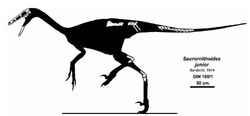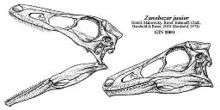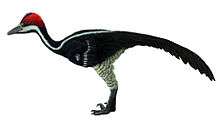Zanabazar (dinosaur)
| Zanabazar Temporal range: Late Cretaceous, 70 Ma | |
|---|---|
 | |
| Skeletal restoration by Jaime Headden | |
| Scientific classification | |
| Kingdom: | Animalia |
| Phylum: | Chordata |
| Class: | Reptilia |
| Clade: | Dinosauria |
| Order: | Saurischia |
| Suborder: | Theropoda |
| Family: | †Troodontidae |
| Genus: | †Zanabazar Norell et al., 2009 |
| Species: | †Z. junior |
| Binomial name | |
| Zanabazar junior (Barsbold, 1974) | |
| Synonyms | |
|
Saurornithoides junior Barsbold, 1974 | |
Zanabazar is an extinct genus of troodontid theropod dinosaur from the Late Cretaceous of Mongolia. The genus was originally named by Rinchen Barsbold as a species of Saurornithoides, S. junior. In 2009 it was reclassified as its own genus, named after the first spiritual figurehead of Tibetan buddhism, Zanabazar. The holotype, GIN 100–1, includes a skull, vertebrae, and right hindlimb. Zanabazar was one of the most derived troodontids, and the second largest after Troodon.
Description
Zanabazar is the largest known Asian troodontid, with a skull length of 272 millimetres (10.7 in). The only other troodontids that appear to be larger than it are specimens from Alaska that are currently classified in the genus Troodon.[1]
History of discovery

In 1974, Rinchen Barsbold described a new specimen of derived theropod from the Bugeen Tsav of the Nemegt Formation, which is dated to about 70 million years ago.[2][1] This specimen, GI No. SPS 100–1, was named by Barsbold as a new species of Saurornithoides, S. junior. The skeleton includes a nearly complete skull and braincase, part of the pelvis, some tail vertebrae, most of the right hindlimb.[2] In 2009 a review of the genus found that the support for S. junior in the same genus as S. mongoliensis was lacking. Mark Norell and colleagues re-classified the species in the new genus Zanabazar, which they named in honor of Zanabazar, the first spiritual head (Bogd Gegen) of Tibetan Buddhism in Outer Mongolia.[1]
Classification
While originally included in Saurornithoides, within the family Saurornithoididae, Zanabazar is now thought to be a derived member of Troodontidae.[2][1]

The cladogram below shows the phylogenetic position of Zanabazar among other troodontids following a 2014 analysis.[3]
| Paraves |
| ||||||||||||||||||||||||||||||||||||||||||||||||||||||||||||||||||||||||||||||
| |
See also
References
- 1 2 3 4 Norell, M.A.; Makovicky, P.J.; Bever, G.S.; Balanoff, A.M.; Clark, J.M.; Barsbold, R.; Rowe, T. (2009). "A Review of the Mongolian Cretaceous Dinosaur Saurornithoides (Troodontidae: Theropoda)". American Museum Novitates. 3654: 63. doi:10.1206/648.1.
- 1 2 3 Barsbold, R. (1974). "Saurornithoididae, a new family of small theropod dinosaurs from Central Asia and North America" (PDF). Palaeontologica Polonica. 30: 5–22.
- ↑ Tsuihiji, T.; Barsbold, R.; Watabe, M.; Tsogtbaatar, K.; Chinzorig, T.; Fujiyama, Y.; Suzuki, S. (2014). "An exquisitely preserved troodontid theropod with new information on the palatal structure from the Upper Cretaceous of Mongolia". Naturwissenschaften. doi:10.1007/s00114-014-1143-9.